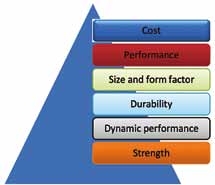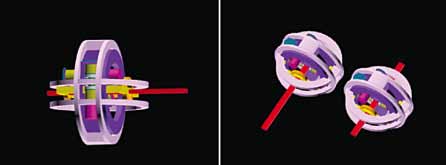Although piezos require far higher voltage than ERMs and LRAs, their extremely quick response rate results in a more power-effcient performance than the others.
Haptic drivers
Another component that is needed for implementing haptics is the haptic driver. The driver is instrumental in providing a touch sensation when the user interacts with a device. It is also capable of creating a more local effect and assures the user of a correct ‘point-of-touch’ on the screen.
Some of the newer drivers, like the FAH4830 haptic driver from Fairchild Semiconductor, are capable of driving both ERM and LRA motors while also performing at a very low wake-up time of less than 30 µs. Quick wake-up time is important if the user experience holds value in the system designer’s plans, as it provides low latency and thus creates a faster and more realistic haptic response.
New haptic drivers also fall in line with the general consensus of design engineers that power efficiencyis vital to the success of a product. Hence the latest drivers feature very low current consumption—the FAH4830 uses less than 500 nA of current on standby. TI also has an interesting haptic driver known as the DRV8601, which works on a quiescent current of 1.7 mA and a shutdown current of 10 nA while featuring a turn-on time of 100 µs.
Implementing a different haptic technique
Next-generation actuator technologies focus more on being able to deliver a wider range of effects by manipulating the response times and frequency of the vibration. One of the most interesting techniques for effecting haptics is ‘reverse-electrovibration.’

You may have experienced a very basic version of this technique if you use a unibody aluminium Macbook Pro notebook computer. Dragging a dry fingerover the laptop creates a characteristic rubbery feeling, although you are actually touching aluminium. This is caused due to the capacitive set-up created by the finge and the metal surface that attracts the finger.
You can create this effect on a system by giving weak current to the device being used or, more specifically to the area of the device that is being used for interaction. If the material is conducting, a capacitive set-up will be created when a dry fingertouches it. The capacitive set-up will generate an oscillating electric feld around the skin and the fingertips, which then go on to create a variable sensation of friction depending on the frequency and amplitude of the applied signal. The ability to control friction by varying the frequency and amplitude will allow to create different ‘virtual’ surfaces as you desire. These surfaces are called virtual because they are only felt to be different—the actual surface remains the same (aluminium in the example above).
Design tips you need to keep in mind
The main challenge in designing a haptic device is to make the control interface feel exactly like the tool being used originally by the operator.
“Take the case of a haptic device that mimics the tools of an endoscopic surgeon. The haptic device has to feel like the tools of a endoscopic surgeon. The actuators and sensors have to be implemented to look almost like that. The major issue would be balancing the weight of different actuators along different axes so that the surgeon feels like he is using his original equipment,” explains Biju R. Varkey, CEO, Designs and Projects Development.
“Another design aspect would be to provide kinetic motion and freedom exactly like he would feel while conducting the said operation on an actual patient. It is also very important to make the software and control mechanism fast and accurate,” he adds.

Haptics applications can be extremely complex as they are expected to produce response to human touch. Therefore integrating haptics into any device requires a confluence of system-level design expertise.
“Appropriate actuators and their respective locations must be selected carefully as these are crucial from an end-user experience point of view. Additionally, software written for the device should not only control but also optimise the actuators to ensure that the quality of the haptics’ sensations is near to reality. Giving consistent experience to the user could be a success factor for such a device. It is important to recognise that designing haptics into any device requires a system-level approach,” advises Tamboli.
“The value of a well-designed multimodal interface can provide great differentiation and an enhanced user experience to consumers. In short, haptics is all about giving feedback to the user in touch-sensation form, and hence it may have cultural influenc too. For instance, softer touch-sense might mean one thing to one type of users while it would mean different (or lesser) to others. Therefore user study and adaptation of the device should be taken critically as it would defin success or failure of the device with haptics,” he said.






